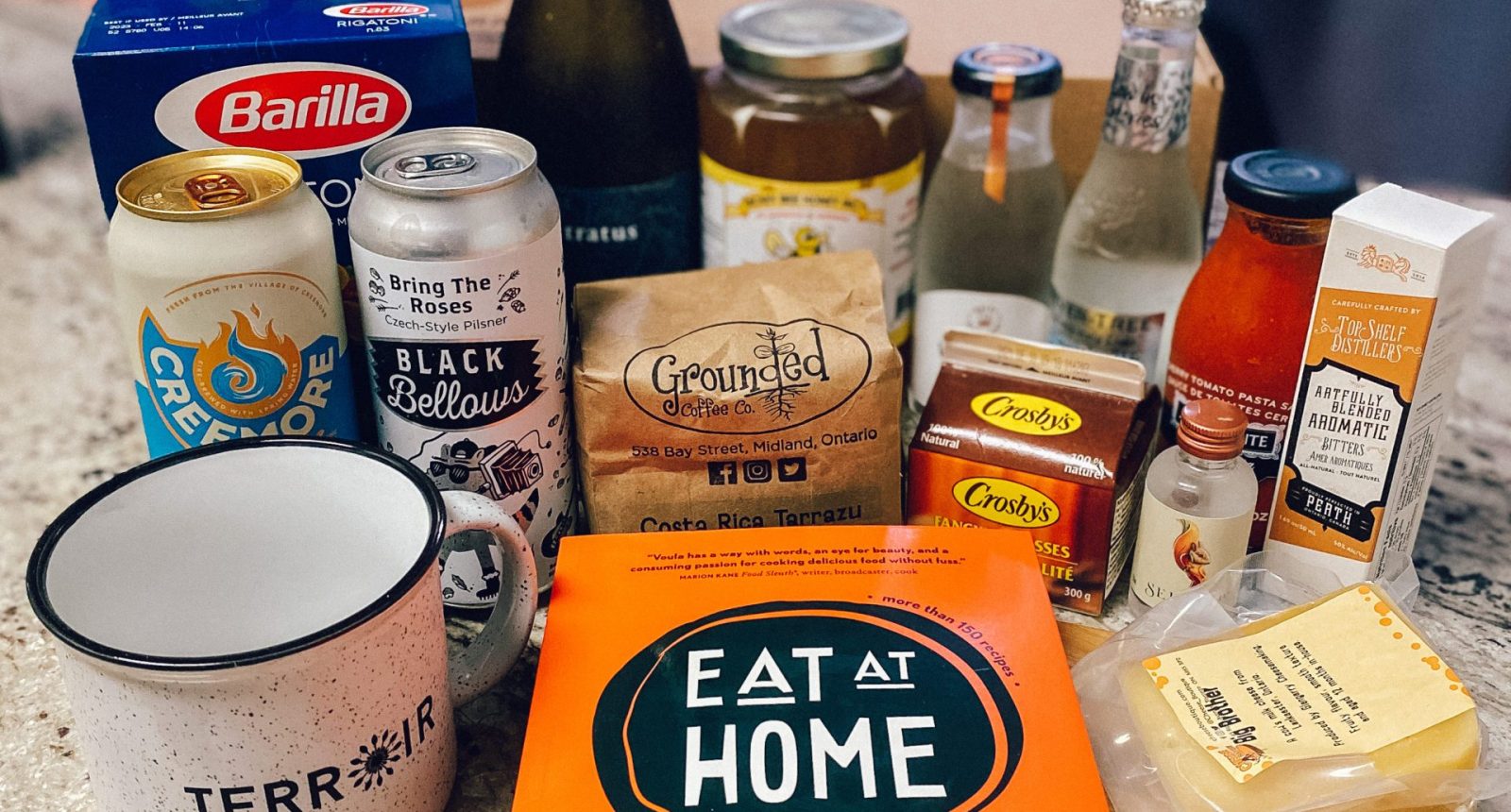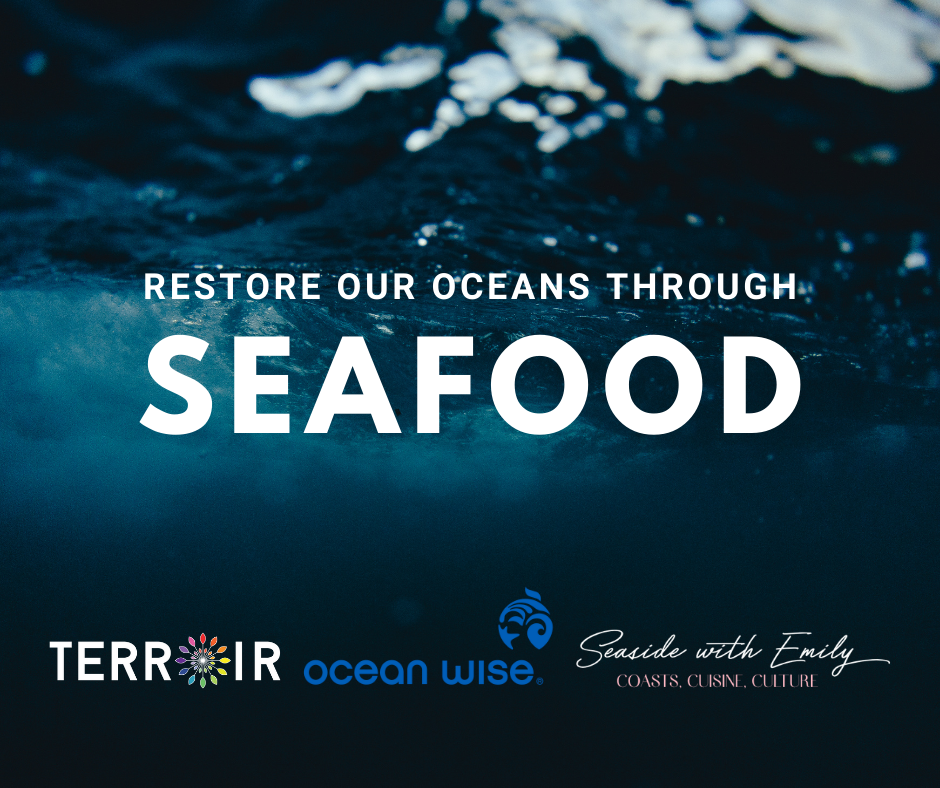

For the past 14 years, the Terroir Symposium has brought the world’s leading innovators in food, tourism and hospitality together to share ideas, make connections, and create change.
This week, the Terroir Symposium went virtual for the first time ever due to the COVID19 pandemic.
While the format was different, Terroir continued to uphold their commitment to supporting Canada’s food, tourism, and hospitality industries.
These industries have been some of the hardest hit by the pandemic. So, the theme of this year’s symposium, “collaboration and partnerships”, was more important than ever.

To make sure that attendees still got the full terroir experience at home, Terroir introduced the “Taste of Terroir Box”. Each box was filled with delicious, innovative products from across Ontario, including VQA wine, Ontario artisan cheese, small-batch spirits, and locally roasted coffee. It was the perfect symposium companion to enjoy during tutored tastings, cook-along classes and workshops!
This year’s symposium was as insightful, exciting, and inspirational as if it had been in person. While I certainly miss the opportunity to connect personally with the great speakers and panelists, I learned so much from them. In today’s post, I want to highlight some of those learnings and share my biggest takeaways from the 2020 Terroir Symposium.
The way people access food is changing
During day two of the Terroir Symposium, Dr. Sylvain Charlebois shared some insights into our changing food landscape.
The way that people access food now is entirely different than it was before the pandemic. There’s been a sharp increase in the use of delivery services, meal kit subscriptions, and takeout dining. This shift comes with its share of pros and cons.
For example, Dr. Charlebois noted how the rise in e-commerce has democratized the food supply chain. As a result of online ordering platforms, everyone now has direct access to the consumer. This opens up a lot of unique opportunities for creativity within the supply chain.
However, the rise in online ordering and takeout purchases has also led to an increase in single-use plastic consumption. Plastic consumption has generally been increased by food services in the last few months due to health safety concerns. Takeout, meal services, and prepping food for transport often results in even more plastic usage.
Nonetheless, consumers now have more unique and innovative ways to connect with their local food suppliers. Dr. Charlebois says this, “has completely changed the rules” for food supply chains. Food services have proved that the opportunities to connect with consumers in endless, paving the way for innovation and creativity in the sector like we’ve never seen before.
When it comes to food supply chains, “the rules have changed”. -@foodprofessor #Terroir2020 Share on XConsumers are becoming more involved in the food system
Another noticeable trend in our food landscape is how active consumers have become in the supply chain.
Let’s face it, most of us often don’t think twice about where our food comes from or the journey it takes to get to our plate. But, in the early months of the pandemic, when food was flying off of grocery store shelves and media was reporting on meat shortages, people began to take matters into their own hands.
Since March, there’s been a growth in the number of Canadians who have been growing their own produce at home. Before the pandemic, only 17% of Canadians had a garden to grow food in. Now that number is closer to 25%.
This attempt to become more self-sufficient is reminiscent of the Victory Gardens during the World Wars, when individuals were encouraged to garden as a tactical strategy to increase food sovereignty.
While the rapid spike in green thumb’s may have been instigated by fear and panic, it could spur a longer term shift in which consumers take control of the supply chain.
People know more about our food systems now and this pursuit for knowledge around food is going to continue.
The whole issue of celebrating food means something different now, people are more aware of what food can do for them, more so than ever before. Share on XChefs have a powerful position and are working to support the Sustainable Development Goals
While restaurant chefs are at the end of the food supply chain, they’re using their position to influence earlier stages and encourage more sustainable food sourcing and provisioning practices.
In a discussion with Paul Newham, chef’s Megha Kohli and Conor Spacey shared some insights on the role that chef’s play in advocating for more sustainable and equitable food systems. They also gave an inside look at the implementation of the Chef’s Manifesto: a chef-led project that brings together 700+ chefs from around the world to explore how they can help deliver a sustainable food system.
Through online outreach and a series of workshops, over 130 chefs from 38 countries have co-created the Chefs’ Manifesto. Developed by chefs, for chefs, the Manifesto outlines the food system issues that chefs are most passionate about tackling. There are 8 core areas in which the Chef’s Manifesto focuses including “ingredients grown with respect for the earth and its oceans”, “investment in livelihoods”, and “education on food safety, healthy diets, and nutritious cooking”.
The power of chef’s also came up during my favourite session: “Putting Canadian Seafood Back on the Plates of Canadians”.
Jason Bangerter, executive chef at Langdon Hall echoed sentiments from the Chef’s Manifesto group about the important role that chef’s play in sustainable sourcing. He also highlighted how he’s bringing this mindset to seafood sourcing at Langdon Hall.
Jason shared personal stories from his experiences as a chef and a food lover that emphasized the importance of eating local. One stand out anecdote from Jason’s presentation was when he shared a story about travelling to Europe and enjoying some of the finest seafood he’d ever enjoyed. When Jason returned, and tried to recreate the dishes at home, they missed the mark. It was then that he realized what makes seafood so delicious, is sourcing it close to home.
Those European seafood dishes tasted so wonderful in Europe, but fell short in Canada. So Jason decided to start crafting seafood dishes that centered Canadian seafood. And to make sure he was getting as close to home as possible, he sourced his fish directly from the fishermen.
Jason also leverages “bycatch” or “trash fish” that would normally be thrown back in the ocean to encourage “eating with the ecosystem”. For example, if you’ve ever seen “rockfish” on a Langdon Hall menu, Jason is to blame. Rockfish is an abundant species in British Columbia that often gets thrown back in favour of other species like salmon or halibut.
But Jason is using his position as a chef to change the demand for these naturally abundant species and encouraging fishermen to hang on to “trash fish”. Those fish are then transformed into delicious seafood plates for Langdon Hall guests.
“As chefs, restauranteurs and foodservice pros – we have a huge responsibility […] let's choose Canadian for our fellow Canadians and choose sustainable for our rivers and lakes, and native species." Share on XSeafood doesn’t always come from the sea: recognizing the power of aquaculture in local food systems
Of course, I was most excited to hear the symposium session all about getting Canadian seafood back on the plates of Canadians.
I really appreciated the unique approach that this session took in reminding us that seafood doesn’t always come from the sea. Susan Cole, president of the Ontario Aquaculture Association, highlighted the abundance of Great Lakes freshwater fisheries and the growing importance of farmed seafood in the province.
While I knew of Ontario’s abundant freshwater fisheries, I had no idea how robust our aquaculture sector was!
Fish farming in Ontario has been happening in Ontario since 1950. Aquaculture in the province produces a variety of species including rainbow trout, pacific white shrimp, tilapia, barramundi, perch, and lake whitefish.
It’s estimated that 62% of seafood will come from aquaculture by the year 2030. Meaning, it’s more important than ever to focus on building local and sustainable aquaculture operations.
Fun fact: Susan Cole is also the owner of Cole Munro foods, the largest producer of farmed rainbow trout in Ontario!
I’ve long been an advocate for seafood as a means to bridge the food security gap. Hearing about the promising aquaculture initiatives in our province only strengthened my confidence in aquatic food systems.

Ontario is a leader in sustainable wine making
The only thing that I love as much as seafood is wine.
I was incredibly excited to hear all about the sustainable winemaking practices of Ontario’s wineries.
If you’re from Ontario, you’ve probably seen the “VQA” label before. The VQA certification means that everything inside the bottle is sourced entirely from the province of Ontario. This is an easy way for Ontarians to spot the most sustainable wine choice.
Plus, each purchase of a bottle of VQA wine generates $98.20 of economic impact for the Ontario economy. 🍷
In addition to VQA, Ontario craft wineries started a certification program in partnership the Grape Growers of Ontario, to encourage even more sustainability in Ontario’s wineries: the “Sustainable Winemaking Ontario”. This program is based on the three pillars of “environment, economy, and community”. It assesses factors like energy efficiency, local material sourcing, and community leadership.
And of course, all wineries carrying this certification produce VQA wines.
I was really excited to see so many of my favourite wineries were “Sustainable Winemaking Ontario Certified” including Pelee Island Winery, Cave Spring Vineyard, and Pilliteri Estates winery.
Understanding the details behind these certifications was really cool, but the main takeaway from this session for me, was how dedicated Ontario’s winemakers are to promoting sustainability. Not only in their own wineries, but globally.
The theme of this session was very much, “think global, act local”.
The panelists spoke at length about the unique position of the wine industry. Producing wine encompasses the tourism, manufacturing, and marketing sectors. This gives wineries a unique platform to push forward sustainability mandates across industries.
When speaking about what sustainability means to him, Gabriel Demarco from Cave Spring Vineyard talked about the need to “never be complicit with the status quo”. The drive to always be better has made Cave Spring successful in marrying tradition and science to produce high quality and sustainable wines.
"We don't have to choose between being environmentally friendly and the profitability of our business." – Matthew Speck of @SpeckBros speaking about @WineCountryOnt Sustainable Winemaking Ontario (SWO) Certification Share on XDean Stoyka of Stratus vineyards ended this session by speaking to the importance of thinking about the broader picture.
Everything from barrels and bottles, to waste disposal and waster usage is considered in the daily operations at Stratus. Dean admitted, this isn’t always glamorous. But when it comes to sustainability, transparency trumps the need to preserve a beautiful image. Stratus is more concerned with getting people involved in the sustainability discussion and empowering the community to make their own moves towards a sustainable future.
“That’s really what sustainability is. It’s bringing everything together into one big picture.”
There were so many incredible discussions at this year’s Terroir Symposium. Narrowing down my key takeaways was an impossible task.
I learned so much about Canada’s rich culinary scene, that frankly, I’d hadn’t been appreciating enough. I’ve said this many times over the last few months, but this pandemic has made me appreciate the beauty that lies outside my front door. It’s reminded me that I don’t need to get on a plane and cross an ocean to experience delicious cuisine, fine wine, or life-changing adventures.
Sorry, the comment form is closed at this time.




Chef JB
👏